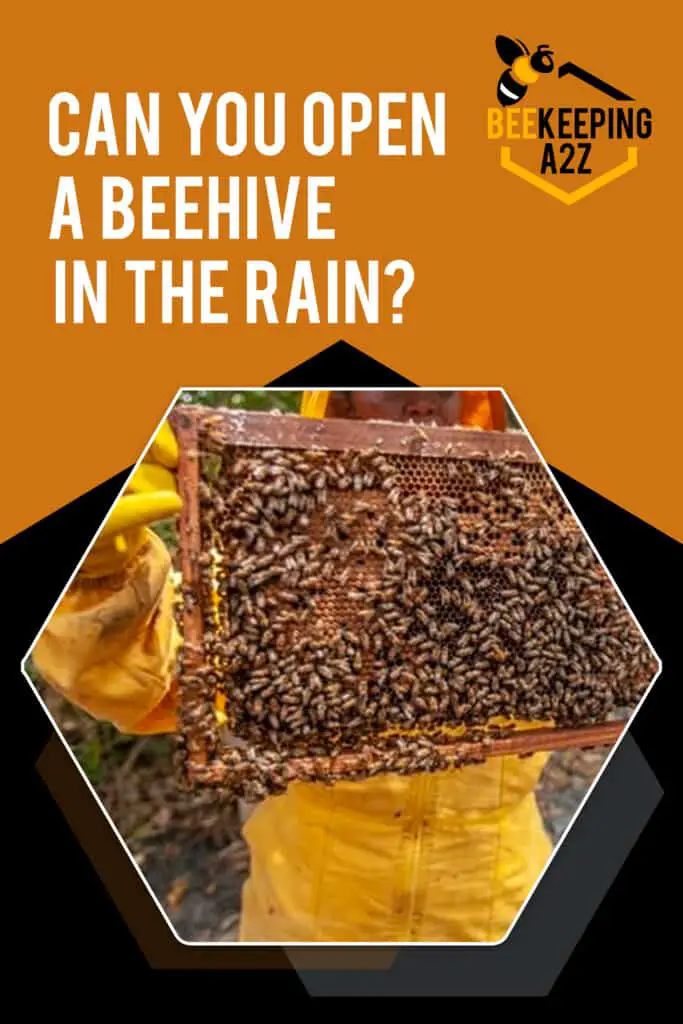Wet hive inspection is a bad idea. Damp weather, grouchy bees, and a high risk of stinging make rainy day inspections difficult. It also puts the bees in further danger.
Honey bees aren’t fond of going out in the rain. Loads of rain will lead to less pollen and nectar available, which is what the hive is working on. Rain would have compromised the flow of nectar, and virtually no one would have been able to harvest a great deal of honey.
The Sun as Navigation of Bees
Bees keep their hives in a much-regulated environment. Their homes are climate controlled down to a degree, and they’re not fans of the invasion of their space. They are very sensitive to smells. Any intrusion into their sweet-smelling dwelling place is enough to alert them and make them angry.
Wet and rainy days bring a new dimension which the bees don’t like, moisture. There are many factors why bees don’t care about the rain. Although they can fly during a downpour, it does not matter, since they use the sun to navigate. Rainy and cloudy days are making it complicated. They face death or being lost while flying on these days. Torrential downpours can considerably delay the flight of the bees and can break the wings of the bees.
Water Sustains Bees
Water is an intricate element in the hive that balances to an exceptional degree. Like any creature, the bees need water to sustain themselves. Regarding foraging nectar for honey, pollen for protein, and tree resin for the production of a sticky substance called “bee glue,” honey bees forage for water. If the nectar is too dense, water can be added to ensure the right moisture balance.
However, most nectar is fanned. This is to reduce its water content to about 18 percent; this process, combined with enzymes added by house bees, transforms raw flower nectar into honey. Why does it all have to do with rain hive inspections?
When we crack open the hive’s outer and inner coverings, we expose the preferably sealed environment to the elements. This brings foreign moisture to the hive. For each inspection, the bees must repair the beekeeper’s damage during the rainy day inspection, with the added function of fanning and removing the moisture. When the evening’s temperatures go below zero, you’ve put your bees in a worse position. Humidity is the enemy of overwintering honey bees, and time is not on their side.
Keeping the Hive Dry
All bees are home during rainy days (winter or summer). Foraging bees are grounded and stand idly waiting. The queen and house bees continue to perform their tasks, but the hive will be in the full population. That means you will come across many bees, and many developed stingers in a grumpy mood due to the rain. Yet many beekeepers learn that rainy day hive inspections are a quick way to increase sting resistance through inoculation.
Beekeepers should keep their hives leaning slightly forward so that the rainwater would not spill into the hive.
This is especially valid if you use a solid bottom board. When you use a screened bottom, the water will spill in even though you have the drawer in place as most drawers fit quite loose. If your bottom board is watertight, you need to deter puddles at the entrance and inside the hive.
Excessive moisture is a bad thing in the hive. A simple roof made of a piece of plywood fixed in place with a ratchet tie goes a long way towards keeping the hive dry if you live in a coastal location. You can also place your hives under a permanent roof.
Often urban beekeepers have their hives on a covered porch or balcony, which can provide sufficient protection against rain. Or you can install a covered hive stand.
Common questions about opening a beehive in the rain
Can Bees Survive in the Rain?
Bees can fly in the rain, but this is dangerous, and they don’t usually fly. If it’s only misting, the mist will build upon the bee’s body and disrupt its flight. The water also slows down the bee and hinders the bee’s wings, which occur about 12,000 beats per minute.
Spring rain is a pleasant sight for a subsistence farmer who is busy sowing seeds and planting crops. Besides that, the same spring rains can turn into catastrophic storms, sometimes leaving beekeepers curious about helping bees survive the storms.
What Do Bees Do Before and During Storms?
Bees do a few things to help them survive storms. One thing they do is fill any creases and crevices with propolis, which acts as a glue to secure the hive. Unless the hive is brand new, it won’t be as good as a hive whose bees have had time to protect their home correctly.
They often behave differently as a storm is going to hit. Usually, you can find less activity around the entrance, as the forager bees remain inside. If some foragers have left the hive already, you will notice they are coming home and not going again.
More bees in the hive means more work to do and more mouths to feed. Forager bees will most likely be reassigned to help control hive moisture and temperature.
How to Help Bees Weather a Storm?
Helping bees in storms depends on the strength of the winds and how long they last.
The bees will be able to take care of themselves for most of the spring storms. However, when severe storms are expected, a reasonable beekeeper will help the bees out by securing the hive and providing additional feed, if necessary.
A full hive is massive. The most significant risk to a hive in a storm is to have it topple over or to have the cover fly off, and then rain will get into the hive. The full superstructure weighs about 60 pounds, and the total depth weighs about 90 pounds. Hives full of honey are going to be hard to get around.
Conclusion
Cool, wet weather affects bees and keeps them in the hive. The warmer the temperatures, the better the bee-activity conditions when the heat is warmer. Having you and the bees soaking wet, the bees, and drowning bees in this situation are some drawbacks. When opening hives in the rain, be prepared to receive an unfriendly welcome from the bees. Some of the guard bees and older foragers are stuck in the hive when it rains, and they can make their presence aware when their roof is removed in the rain. If it is not an emergency. Wait for better weather.

